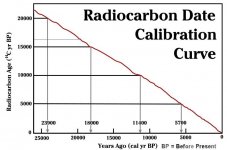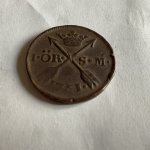OntarioArch
Sr. Member
One of our responsibilities to the science of Native American archeology is to be as careful as we can with dates and ages. By following a few simple naming conventions, we can more accurately convey the awesome antiquity of these artifacts that inspire us all.
Cambridge University (…not a bad little school….) publishes guidelines stating that “BP” is understood as a symbol meaning precisely “conventional radiocarbon years before AD 1950.” Or, it is acceptable to use “14C yr BP.” (Some academic publications require that the testing laboratory and error range be included.) This is a generally accepted publishing convention.
Once the radiocarbon years have been calibrated, they are to be expressed as cal BC, cal AD, or cal BP. Some academic journal articles use cal yr BP instead of cal BP. Both are acceptable. Caution: the abbreviation cal means calibrated, it does not mean calendar! It is also understood that calibrated dates are only an estimate, and have an error range associated with them. So they are not exactly the same as true, absolute calendar years.
True calendar ages may be expressed as “calendar yr BP”: that is, absolute years before 1950. But Cambridge suggests it is “less ambiguous to express such dates as simply AD or BC.” Again, the abbreviation cal means calibrated: does not mean calendar!
One of my favorite books, Boudreau’s beautiful A New England Typology of Native American Projectile Points, uses a unique – some would say confusing - method of expressing dates and ages: "Most of the dates reported in type definitions are typically expressed in B.C. or A.D. years. More recent definitions express dates in BP years. All of these designations represent uncorrected radiocarbon dates." (“uncorrected” is understood to mean “uncalibrated”) So even BC and AD dates are uncalibrated radiocarbon years, in contravention of generally accepted publishing guidelines! A quick survey of other published archeological studies indicates that AD and BC adhere to the Cambridge standard: they represent calendar years.
Boudreau’s publication falls into its own unconventional trap in several instances. For example, a passage that states that artifacts, “have been dated…to 10,616 cal yr BP” is represented on the associated timeline as 10,600 BP. The author and editor have conflated calibrated radiocarbon years BP with uncalibrated radiocarbon years BP. In this particular example, it is an error of some 1500 calendar yr BP.
Another type of confusion involves this book’s use of phrases such as “years ago.” An artifact “dated to about 4200 years ago” is represented on the associated timeline as 4200 BP. So, apparently, this book uses “years ago” to mean “uncalibrated radiocarbon years ago.” Same thing happens with “years old” and “a span of 500 years.” What kind of years are we talkin’ about here?
Is it really appropriate to use “years old” to mean uncalibrated radiocarbon years? Academic journal articles – the standard bearers of archeology research - routinely indicate age by using cal yr BP; that is, calibrated radiocarbon years before 1950. And journals also use AD and BC to mean absolute calendar dates, when that data can be determined. I can find no examples, other than Boudreau’s Typology, that use AD and BC to mean uncalibrated radiocarbon dates.
Conflating terminology and ignoring academic reporting conventions, confuses those who want to learn more about the topic.
So, how old is that Paleoindian artifact of yours?
Cambridge University (…not a bad little school….) publishes guidelines stating that “BP” is understood as a symbol meaning precisely “conventional radiocarbon years before AD 1950.” Or, it is acceptable to use “14C yr BP.” (Some academic publications require that the testing laboratory and error range be included.) This is a generally accepted publishing convention.
Once the radiocarbon years have been calibrated, they are to be expressed as cal BC, cal AD, or cal BP. Some academic journal articles use cal yr BP instead of cal BP. Both are acceptable. Caution: the abbreviation cal means calibrated, it does not mean calendar! It is also understood that calibrated dates are only an estimate, and have an error range associated with them. So they are not exactly the same as true, absolute calendar years.
True calendar ages may be expressed as “calendar yr BP”: that is, absolute years before 1950. But Cambridge suggests it is “less ambiguous to express such dates as simply AD or BC.” Again, the abbreviation cal means calibrated: does not mean calendar!
One of my favorite books, Boudreau’s beautiful A New England Typology of Native American Projectile Points, uses a unique – some would say confusing - method of expressing dates and ages: "Most of the dates reported in type definitions are typically expressed in B.C. or A.D. years. More recent definitions express dates in BP years. All of these designations represent uncorrected radiocarbon dates." (“uncorrected” is understood to mean “uncalibrated”) So even BC and AD dates are uncalibrated radiocarbon years, in contravention of generally accepted publishing guidelines! A quick survey of other published archeological studies indicates that AD and BC adhere to the Cambridge standard: they represent calendar years.
Boudreau’s publication falls into its own unconventional trap in several instances. For example, a passage that states that artifacts, “have been dated…to 10,616 cal yr BP” is represented on the associated timeline as 10,600 BP. The author and editor have conflated calibrated radiocarbon years BP with uncalibrated radiocarbon years BP. In this particular example, it is an error of some 1500 calendar yr BP.
Another type of confusion involves this book’s use of phrases such as “years ago.” An artifact “dated to about 4200 years ago” is represented on the associated timeline as 4200 BP. So, apparently, this book uses “years ago” to mean “uncalibrated radiocarbon years ago.” Same thing happens with “years old” and “a span of 500 years.” What kind of years are we talkin’ about here?
Is it really appropriate to use “years old” to mean uncalibrated radiocarbon years? Academic journal articles – the standard bearers of archeology research - routinely indicate age by using cal yr BP; that is, calibrated radiocarbon years before 1950. And journals also use AD and BC to mean absolute calendar dates, when that data can be determined. I can find no examples, other than Boudreau’s Typology, that use AD and BC to mean uncalibrated radiocarbon dates.
Conflating terminology and ignoring academic reporting conventions, confuses those who want to learn more about the topic.
So, how old is that Paleoindian artifact of yours?
Amazon Forum Fav 👍
Attachments
Upvote
6







